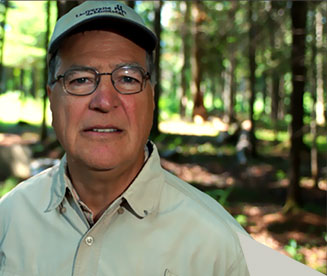Video produced by ArchAnge Films for the Sherbrooke Museum of Nature and Science
Narrator: Éric Graillon, archaeologist, Sherbrooke Museum of Nature and Science
Date: June 2015
Location: Kruger 2 archaeological site in Sherbrooke (Quebec)
Length: 2:48
Two archaeology sites have been identified on the banks of the St. Francis River in the Eastern Townships: The Kruger 2 site, named for the pulp and paper factory where it is located, and the Gaudreau site in Weedon. Éric Graillon, archaeologist at the Sherbrooke Museum of Nature and Science, provides an overview of the discoveries and their contribution to understanding the settlement of the Eastern Townships.
Éric Graillon is standing in front of the Kruger 2 site, providing explanations. The background features trees and two people inspecting the dig site.
[Éric Graillon] Hello, my name is Éric Graillon. I am an archaeologist at the Sherbrooke Museum of Nature and Science. I am working at a site in the Sherbrooke region, along the St. Francis River in southern Quebec.
On-screen text : An overview of the discoveries [É.G.]Until recently, the oldest occupancies of the St. Francis River watershed dated back some 6 000 to 6 500 years. At that time, Indigenous peoples regularly visited the St. Francis River watershed. There was no trace of any older occupancy. It wasn't until 2011 that a site dating back to the Palaeoindian period was first discovered, on the Gaudreau site in Weedon, located at the confluence of the Salmon and St. Francis rivers. It was a small settlement. Hunters made a stop there and maybe cleaned their tools before continuing on their journey. Two years later, while an inventory was being conducted in the City of Sherbrooke’s Borough of Brompton, a second site was discovered. The people who spent time there may have been the same from the Weedon site, but the inhabitation was of a larger scale.
On-screen text: Their contribution to the understanding of the settlement of the Eastern Townships
[É.G.] When they arrived in the region, about 10 000 years ago, the occupants of the Kruger site, here in Brompton, like the occupants of the Gaudreau site in Weedon, were the first to use local resources. Different materials from the region that they used to make their tools have been found. In addition, they had brought materials from other regions, which they had perhaps acquired through trading, possibly on their travels since they moved around a great deal. These materials were from Maine, others from New Hampshire, even some from the Lake Champlain region.
On-screen: Images of four people inspecting two wells on the dig site.
[É.G.] We are currently in the early stages of excavation and still have a lot to learn about these people, but we can undoubtedly state that representatives of the Plano culture were well established in the St. Francis River watershed about 10 000 years ago.
On-screen text: An anecdote
Éric Graillon holding a stone in his hand.
[É.G.] The stone in my hands holds a lot of meaning for us. When we found the Kruger site here in 2013, we were conducting an inventory. My assistant Sylvain came to see me. In his surveys, he had found two small pieces of this stone. He came to show them to me. We immediately looked at one another and knew that we had just discovered a second Palaeoindian site along the St. Francis River, simply because the tools that had been found in Weedon three years earlier had been chipped from this same material, which was unknown elsewhere along the St. Francis River watershed.






